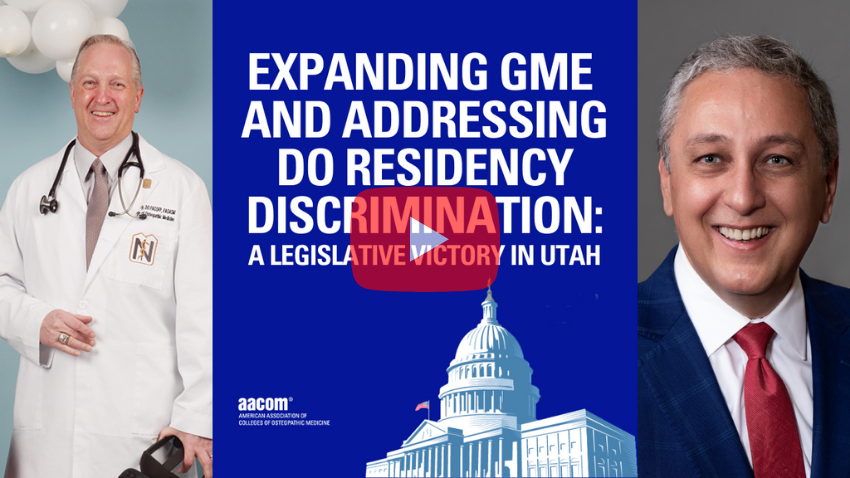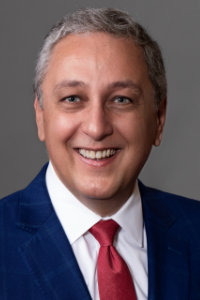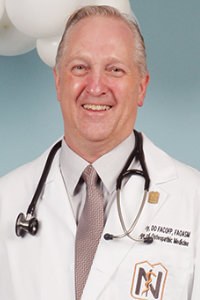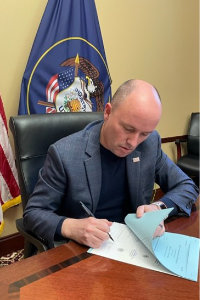Expanding GME and Addressing DO Residency Discrimination: A Legislative Victory in Utah
Published March 29, 2022
The American Association of Colleges of Osteopathic Medicine (AACOM) is committed to ensuring that all osteopathic medical school graduates have access to residency training positions. While the lion’s share of graduate medical education (GME) funding for residency is provided through the federal government, state governments also contribute to physician training. The Utah State Legislature recently passed state GME legislation that was spearheaded by John J. Dougherty, DO, founding dean and chief academic officer of the Noorda College of Osteopathic Medicine (Noorda-COM). Dr. Dougherty effectively advocated for a bill sponsored by Utah State House Representative A. Cory Maloy to provide state funding to create new and expand existing medical residency programs in Utah, including a provision to ensure recipients treat both DO and MD applicants equally. AACOM spoke with Dr. Dougherty and Representative Maloy about their efforts to enact this vital legislation and their advice for how other colleges of osteopathic medicine can pass similar legislation in their states.
 |
| Utah State House Representative A. Cory Maloy. |
The answers below have been edited for brevity and clarity.
Q: Representative Maloy, as the bill’s sponsor, could you please describe the legislation?
Rep. Maloy: This legislation is straightforward and simple, but it took a lot of work to get everybody to see its vision. Basically, it allocates state higher education funds to institutions to start or expand residency programs. Programs are allowed to access these funds until they can find sustaining funds to carry the program forward. In the first year, we allocated $5 million for residency programs as well as a fellowship program for psychiatric doctors. After the first year, we allocated $1.5 million for the residency programs and $500,000 for the fellowship program each year.
 |
| John J. Dougherty, DO, founding dean and chief academic officer of Noorda-COM. |
Dr. Dougherty: We are a meaningfully underserved state relative to GME, and on top of that, Utah is 44th in the nation relative to patient-to-physician ratio, based on 100,000 population. Utah has also been a traditionally small state that is now experiencing a significant boom. Take our county alone. When I moved here three and a half years ago, our population was about 570,000. We're already up to almost 680,000 and we're projected to be at 1.3 million by 2030. Healthcare infrastructure was already stretched, not to say they don’t do an amazing job on healthcare in Utah, they do, but patient access was really starting to become a pressure point. This legislation allows Utah’s medical schools to work collectively with health systems to develop and create new programs in areas of need. That's a key point of the legislation—the area-of-need requirement. All fellowships and programs must address a specific patient care access need here in Utah. That's why this legislation is a big victory for patients. We also have two new osteopathic medical schools in the state. We've tripled the number of medical students here. Utah has always been a net exporter of medical students. About 240-300 students leave Utah every year to go to medical school elsewhere, and these two schools provide Utah students the opportunity to stay in-state. Now, by increasing the number of residency slots—we hope to double them from 400 to 800 in the next five to seven years—we will also help more students complete their training here and go on to take care of Utah’s patients.
 |
| Utah Governor Spencer J. Cox signing this bill into law. |
Rep. Maloy: One of the key points of this bill is that it helps expand current residency programs, which will significantly help our rural areas where healthcare access issues are most pronounced. These communities might have clinics or small community hospitals that cannot start their own residency programs, but larger residency programs could expand and train residents in those areas. We also have a severe mental health physician shortage in our Department of Corrections. The bill’s fellowship program encourages psychiatric doctors to apply for the fellowship and then make a commitment to the corrections department. That’s significant because we have a new, larger prison coming online at the end of this year. Also, as Dr. Dougherty said, we have great medical schools in Utah, but studies show that if students do their residency training out of state, they just don't come back. We're hoping that if students can get their education here and do their residencies here, then they'll start practicing here. Schools like Noorda-COM have done a great job recruiting students from Utah. I think half or even slightly more than half are Utah residents, so we'd like them to learn here, get their experience here and practice here.
Q: Dr. Dougherty, to qualify for the grants this legislation enacts, residency programs must treat DO and MD applicants equally. Why did you think this provision was needed?
Dr. Dougherty: I know this has been a challenge nationwide, but we had great support from the hospital and medical associations here in Utah. This institutional support was meaningfully positive in helping us get that language in the legislation. In Utah, we have a great need for primary care, pediatrics, family medicine, internal medicine and psychiatry. Traditionally, osteopathic graduates lean toward these specialties. That language will provide more opportunities for osteopathic medical students to be considered for those programs here in the state and help provide the best access to care for our patients.
Q: Representative Maloy, what was the most difficult part of gaining support from legislators for this legislation? Were there any surprises? Was there any opposition to including a provision that required treating DOs and MDs equally?
Rep. Maloy: There was very little, if any, opposition. That was probably my biggest surprise as a legislator. Usually there's opposition in some form. However, getting to this point took a fairly long time. We started working on this three and a half years ago. Early on, we began gathering support from other legislators, including former Majority Leader of the Utah House of Representatives Francis Gibson, who now serves as chairman of the Noorda-COM Board, and Representative Steve Eliason, who has a lot of experience in this area and was able to help provide information and insight on whose support we needed. We also recruited a very strong Senate sponsor, Utah State Senate Majority Leader Evan Vickers. Then Dr. Dougherty and his team helped get the Utah Medical Association and Utah Hospital Association on board, and Noorda-COM brought their students and executive team to the Utah State Capitol to meet with legislators in support of the bill. Working with our policy analysts and legal team, we came up with the funding numbers that would help solve this issue without being too high to feasibly pass. It was a real all-out effort that required a lot of thought, process and support, but really, the concept behind the bill isn’t a hard one to grasp. In Utah, we have a physician shortage, and rural health is very, very important, so people understood what this legislation would accomplish and that it would really work for Utah. Once we start seeing results, we may even be in a position, in a session or two, to ask for more money. There’s a study that shows Utah is going to need about a thousand new physicians by 2030. That's coming up fast and our population is growing rapidly, so we are hoping to build on this success.
Photo: Noorda-COM students and administrators advocating at the Utah state capitol.
Q: Dr. Dougherty, how did you demonstrate the need for such a significant state-level investment in GME? What steps did you take to build support with the legislature and other stakeholders?
Dr. Dougherty: Our first steps were to identify which of Utah’s hospitals were eligible for the sustainability of Centers for Medicare and Medicaid Services funding. We have a very unique situation in Utah because we had 23 hospitals that were eligible and uncapped. I took that information to the chief medical officers and the CEOs of the health systems. Once I had buy-in from the CEOs, I went to the hospital association and got their buy-in too. Then we determined what the financing would look like relative to those institutions and worked with the state medical associations to get their support. Then we met with Representatives Maloy, Gibson and Eliason and, quite honestly, they wanted us to put our money where our mouth was, so Noorda-COM invested in a feasibility and social impact study through Tripp Umbach. We also have an in-state physician workforce group out of the University of Utah, and we matched up the finances with the workforce needs. We also met with the other two medical schools in the state. The University of Utah was 100 percent on board, and Dr. Forstein from Rocky Vista University College of Osteopathic Medicine was also supportive. Once we brought all these efforts together, Representative Maloy did an unbelievably amazing job of moving this bill forward. We put in a little bit of elbow grease and got unanimous votes in both houses. I have never been so excited in my whole life! And a very helpful point for any school hoping to pass this type of legislation somewhere else is, and I think it was Representative Eliason who had this very smart idea, to introduce the bill through the higher education committee, not through health and human services. That was key for us in moving this bill through as quickly as we did. Often, this type of legislation never gets out of committee because it gets assigned to the wrong committee, so it's to his credit that he had us bring it through higher education. When we went through the Senate we did go through health and human services, but the ball was already rolling by that point. All these efforts together helped us succeed.
Q: This legislation serves as a helpful model for others who are interested in advancing similar legislation in their states. What advice would you share with others to help them successfully move similar legislation?
Rep. Maloy: It’s important for anybody who wants to run legislation like this to figure out early on where the money is going to come from. For this bill, we were initially planning to bring it out of the general fund, but we realized very quickly that there was too much demand on this fund, while there was a lot of money already allocated in the education fund, which includes higher education. The basic lesson is to make sure you know where your money source is, because as legislators across the country probably already know, everybody's asking for money, and you're going to be competing for that money. If you can strategically figure out where the best source of money is, it makes it a lot easier.
Dr. Dougherty: The bottom line is the bottom line. The reason we got the hospitals, health systems and the hospital association involved is because we demonstrated sustainability. This legislation will only give them grant money to start a program for up to 24 months. After that, they have to stand on their own two feet. Doing the performance analysis and taking it to the executive leadership of the health systems to show them that it is sustainable and all they need is the bridge money was the biggest key to success from my side.
AACOM thanks Dr. Dougherty and Representative Maloy for their important work to pass this vital legislation.
You can advocate to end DO bias and discrimination in GME by visiting AACOM’s Action Center. AACOM will also be uniting the collective voice of the osteopathic medical education community on this and other important policy issues during AACOM Advocacy Day from June 28-29, 2022.
